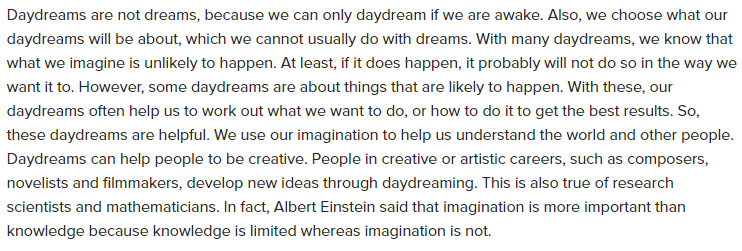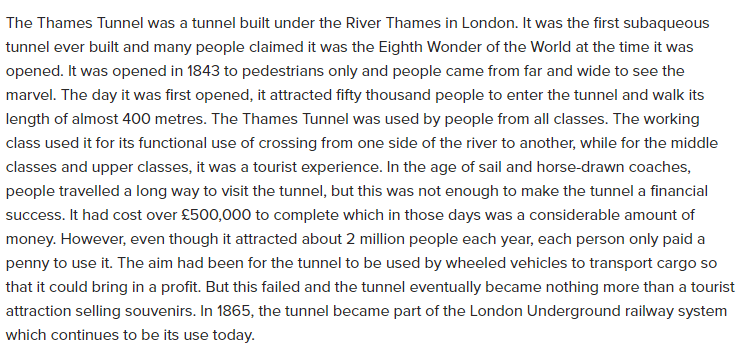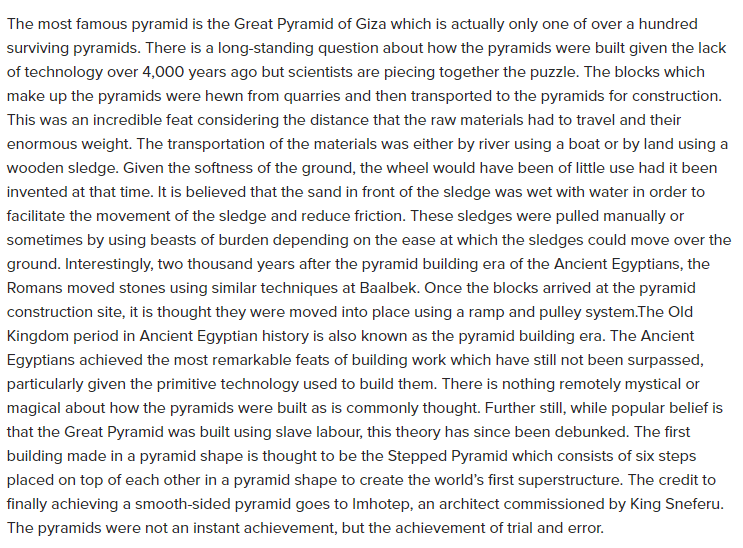Chapter 15 Section 1 Guided Reading an Age of Uncertainty Answers
Contents
- i Strategies for answering the True False Non Given Questions
- ii Tips for Truthful False Not Given IELTS Reading Questions
- 3 Truthful False Non Given IELTS Reading Example i
- 3.one Questions:
- 4 Answers:
- 4.1 Explanation:
- 5 True False Not Given IELTS Reading Example two
- 5.i Questions:
- 6 Answers:
- vi.1 Caption:
- 7 Truthful Fake Not Given IELTS Reading Instance three
- 7.one Questions:
- eight Answers:
- viii.i Explanation:
- 8.two Here are the 10 examples for the Truthful Fake or Not Given
This article helps the test taker sympathise, how to answer the Truthful False Not Given IELTS reading questions. In the Reading section, y'all volition have a text as well as a list of facts. The examination taker has to identify whether the facts are True Faux or Not Given by referring to the text that is given. Right next to the facts yous need to write True, if the fact matches the text, FALSE, if the fact does not match with the text and Not GIVEN, if the fact is not present in the text.
Strategies for answering the True Imitation Non Given Questions
There are a few True Faux Not Given strategies, which have to exist borne in mind while answering the questions. They are listed below:
- The questions are asked in the aforementioned order in which the text or the data is given.
- In order to know the correct answer, you demand to empathise the text given and check which fact near the text is True False or Not Given.
- Read the get-go paragraph carefully and endeavour to respond the questions. If yous observe the respond then practice not rush to write it. Read the sentence advisedly and and then decide whether the answer is correct or incorrect. When you don't find the answer in the first paragraph move to the 2d paragraph and repeat the procedure.
- Y'all have to read the information text carefully, to discover whether the keywords in the question are present in the text.
- Y'all have to continue in mind that the text will be paraphrased ( rephrased i.east., the question may be worded with synonyms of the words contained in the text).
- If y'all look at the controlling words in the information, then you can hands find whether the fact given is True Fake or Not Given.
- Exercise not spend a lot of time on ane question. If you cannot detect the fact in the information and then the answer is probably Not GIVEN.
- Sometimes words like Yep, NO, NO INFORMATION are used. These may be slightly different, where you may have to expect for the opinions instead of the facts.
- Instead of focusing only on the keywords, try to read the sentences completely and identify the answer.
- Friction match the facts given with the correct and authentic information in the text.
- In one case you feel that a item fact matches the text yous need to read information technology again, to know if the fact given is Truthful or FALSE. You need to go along in mind that, if the fact is TRUE, then there should be an exact match.
- If you are really unsure and cannot understand the synonyms given, and then you lot tin marking it equally NOT GIVEN.
- Underline the words which you feel might be the correct answer and then that yous can refer them at the end.
Not certain how to successfully complete the True/Imitation/Not Given section? In our all-time IELTS online classes, nosotros teach constructive tips and strategies to assist you score higher.
Besides cheque:
- IELTS Reading
- IELTS Reading tips
- IELTS Reading contempo actual test
- IELTS past paper pdf
Tips for True False Not Given IELTS Reading Questions
Some tips to answer the questions and obtain a high band in the IELTS examination are given below:
- Before you rush in to write the answer, spend time on understanding the question that is given.
- Practice not make any assumptions nearly the facts given. If yous already know about the topic given, go on information technology aside and focus on the text that is given. Because your assumption may exist incorrect and may atomic number 82 to loss of marks.
- Do not depend only on the keywords that are given. It is recommended to read the text and the question with full concentration.
- There will be many sentences in the text which are paraphrased from the facts that are given. So yous need to be more than conscientious and wait for such sentences. For this, you should possess a practiced vocabulary and must know the synonyms and antonyms of various words.
- Some of the words similar some, never, always, believe, claim, may completely change the meaning of the sentence. That is why it is important to read the sentence carefully to avoid making mistakes.
- It is not simply based on the keywords. Sometimes, the keywords may exist the same simply the meaning of the judgement may be completely different.
- In the facts given, in that location volition be at least one answer that is Truthful False or Non Given.
- The answer will be Imitation when the data in the text states i pregnant and the fact given states some other meaning.
- The lodge of the question given besides may assistance in finding the respond. The answer to question 4 will exist between the answers of questions 3 and 5 in the text.
- If you have no idea nearly the reply, and so write Not GIVEN, considering probably the answer will non be available in the text.
- You can write the initials T instead of writing TRUE, but you need to make certain that your handwriting is clear and readable.
- You lot should solve the IELTS Truthful Fake Not Given do materials available on the internet.
True Fake Not Given IELTS Reading Case 1

Questions:
1. We can decide what to dream
2. Not all day dreams come true.
iii. Twenty-four hours dreaming helps in formation of new ideas.
4. Day dreams may become dreams.
5. Issac Newton said that imagination is more of import than knowledge
Answers:
1. We can decide what to dream – Imitation
2. Not all mean solar day dreams come true. – TRUE
three. Day dreaming helps in formation of new ideas – True
4. Day dreams may become dreams. – NOT GIVEN
5. Issac Newton said that imagination is more important than noesis – False
Explanation:
Now, could yous guess the reason behind the answers?
For the first question, "decide" ways "choose" . From the passage nosotros understand that, we choose what our daydreams volition exist about, which we cannot usually do with dreams. And then nosotros cannot determine what to dream. Hence the statement is False
For the second question, the passage clearly states that many day dreams are unlikely to happen and just some mean solar day dreams are likely to happen. So the statement is Truthful.
For the third question, "formation" also means "evolution". From the passage we empathize that, people in artistic fields develop new ideas through daydreaming. So the statement is Truthful.
For the 4th statement, it is not mentioned anywhere in the passage that there is a possibility of a day dream to become a dream. So it is NOT GIVEN.
For the 5th question, the passage clearly states that information technology was Albert Einstein who said that imagination is more of import than knowledge. And so the argument is Simulated.
True Faux Not Given IELTS Reading Instance 2

Questions:
- The Thames Tunnel was the first tunnel ever built under a river.
- The Thames Tunnel was the 8th Wonder of the World.
- The tunnel was used more than by the eye and upper classes.
- People were able to travel past sea or land in those days.
- The aim of the tunnel was to turn a turn a profit as a tourist attraction.
Answers:
- The Thames Tunnel was the start tunnel ever built under a river. – True
- The Thames Tunnel was the Eighth Wonder of the World. – FALSE
- The tunnel was used more by the middle and upper classes. – NOT GIVEN
- People were able to travel by bounding main or land in those days. – Truthful
- The aim of the tunnel was to turn a profit as a tourist attraction. – Imitation
Explanation:
For the first question, "It was the start subaqueous tunnel ever congenital…", this judgement from the passage clearly indicates that the Thames Tunnel was the first tunnel ever congenital under a river. The give-and-take "subaqueous" which ways existing, formed, or taking place underwater is also an indicator of the same. Hence the statement is Truthful.
For the 2nd question, ".. .many believed it was the Eighth Wonder of the World at the time…. .. ", this judgement from the passage clearly indicates that it was something people believed at that time. It was not a fact. Hence the argument is Faux.
For the third question, the passage does non land how much each course used the tunnel. So it is Non GIVEN.
For the fourth question, "In the age of sail and horse-fatigued coaches. "canvass" refers to boats (body of water) and "equus caballus-drawn coaches" were the method of land travel, indicating that the statement is TRUE.
For the fifth question, "The aim had been for the tunnel to be used past wheeled vehicles to transport cargo so that it could bring in a profit.", indicates that the aim of the tunnel is non to turn a turn a profit every bit a tourist attraction. Hence the argument is FALSE.
True Fake Non Given IELTS Reading Instance 3

Questions:
- The controversy over the method used in the structure of the pyramids has been solved by scientists.
- It is possible that Ancient Egyptians could accept lubricated paths to help transportation past sledge.
- Sledges were dragged past animals not humans.
- The Romans learned the techniques of moving huge stones from the Aboriginal Egyptians.
- The building work of the Ancient Egyptians is unrivalled.
Answers:
- The controversy over the method used in the construction of the pyramids has been solved by scientists. – False
- Information technology is possible that Ancient Egyptians could have lubricated paths to aid transportation past sledge. – True
- Sledges were dragged by animals, not humans. – False
- The Romans learned the techniques of moving huge stones from the Ancient Egyptians. – Not GIVEN
- The edifice piece of work of the Aboriginal Egyptians is unrivalled. – TRUE
Caption:
For the showtime question, ".. scientists are piecing together the puzzle." This sentence from the passage conspicuously indicates that the work of scientists is currently a work in progress. Hence the statement is Imitation.
For the second question, "It is believed that the sand in front of the sledge was wet with h2o in order to facilitate the movement of the sledges and reduce friction." This sentence from the passage indicates that Aboriginal Egyptians could take lubricated paths to assist transportation by sledge. Hence the statement is Truthful.
For the third question, "These sledges were pulled manually or sometimes by using beasts of burden . .. ". Manually meaning by hand (people) and beast of burden meaning animal, indicating that the sledges were as well dragged past humans. Hence the statement is FALSE.
For the fourth question, the passage gives no information about who the Roman's learned from. Then it is NOT GIVEN.
For the 5th question the argument is TRUE since the sentence from the passage, "The Ancient Egyptians achieved the almost remarkable feats of building piece of work which have nevertheless non been surpassed…..", conspicuously indicates the same.
Here are the 10 examples for the Truthful Faux or Non Given
- Instance 1
- Instance 2
- Example 3
- Example four
- Example 5
- Case 6
- Instance 7
- Example eight
- Example 9
- Instance 10
whitfieldgrals1963.blogspot.com
Source: https://ieltsmaterial.com/true-false-not-given-ielts-reading/
0 Response to "Chapter 15 Section 1 Guided Reading an Age of Uncertainty Answers"
Post a Comment